 |
| Anatolia has given rise to many civilizations in the course of history. Although not as advanced as Egypt or Mesopotamia, the Hatti, who spoke a language characterized by prefixes, were nevertheless one of the more advanced societies of their age(3000-2000B.C.). The objects on display at the Ankara Museum of Anatolian Civilizations constitute the finest Bronze Age collection in the world next to the Ur Treasure in the British Museum. |
|
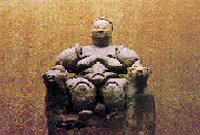 |
|
| The Ankara collection, dated at 2000-1900B.C., comes from tumuli at Alacahoyuk, Horoztepe and Mahmatlar, and includes artifacts in gold silver, electrum bronze and ceramic. |
|
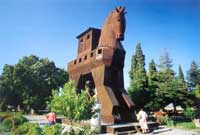 |
|
An Outpost Against Invasion From The Balkans: Troy
During the time of the Hatti, Troy I (3000-2500) and Troy II (2500-2200) represented the Bronze Age in northwestern Anatolia, that is to say at Canakkale. Both fell within the sphere of Aegean culture, and Troy II had a particularly brilliant age. The gold vessels unearthed by Heinrich Schliemann, and kept in the Berlin Volkerkunde Museum, unfortunately vanished during World War II. |
|
| The riches of Troy are now represented by the gold jewellery on display in the Istanbul museum of Archaeology. Troy III-V (2200-1800B.C.) is a continuation of Troy II.
Migration Of Indo-European Peoples Into Anatolia - The Hatti-Hittite Princedoms
The Indo-European migrations, which took place over a vast territory extending from Western Europe to India, brought some peoples over the Caucasus into Anatolia. The Nesi people settled in Central Anatolia, the Pala in Paphlygonia, and the Luwians in Southern Anatolia. In the course of these migrations the new arrivals gradually captured the Hatti princedoms to form first the Old Hittite Kingdom (1660-1460 B.C.), and than the Great Hittite Kingdom(1460-1190 B.C.). |
|
| The Hittite Empire (1660-1190 B.C.)
The Hittites founded a federative feudal state, and during their final two centuries constituted one of the two superpowers of the age, the other being Egypt. Indo-European in origin, the Hittites recognized equality between men and women, and indeed their law incorporated rights even for slaves. No other legal system in the world at that time was so advanced. Although the monarchy passed from father to son, this was a kingship based on the idea of "primus inter pares", first among equals, for the ruler was required |
|
 |
|
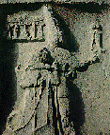 |
|
to bring many matters before the senate, which was made up of aristocrats known as the Pankus class. At a time in the Near East when the flaying and impaling of enemies was the rule, when heads and hands would be lopped off and pyramids made of them, the Hittites were astonishingly humane, almost like civilized of nations today.
The Hittites adopted the Hatti religion, mythology, language and customs, as well as their names for places, mountains, rivers and persons. |
|
| Because the Mesopotamians called Anatolia "the Land of the Hatti", the newcomers were mistakenly given the name "Hittite".
Hittite architecture was highly original, and included the strongest city walls of the Near East in the second millennium B.C. They also built the most magnificent temples, and developed a figurative art that was to be widespread in Anatolia. |
|
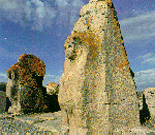 |
|
| The Ilium of Homer's Iliad Troy VI (1800-1275 B.C.)
As the Hittites were settling in Central Anatolia, another Indo-European people were flourishing in the Canakkale region at Troy VI, which today is one of Turkey's finest ruins, with a city wall preserved to a height of four meters, and a number of well preserved megaron type houses.
The Ilium of King Priam, in Homer's epic, corresponds to layer VIh(1325-1275 B.C.), and was destroyed in an earthquake, while the city captured by the Achaeans was Troy VIIe (1275-1240/1200 B.C.). When Troy VIh was destroyed in an earthquake in 1275 B.C., followed by the pillaging of Troy VIIa in 1240/1200 at the hands of The Achaeans, a staunch outpost against incursions from the northwest- an outpost which had stood for two thousand years was gone.
And indeed, the crude hand-made pottery discovered in Troy VIIb2 / 1240-1190 B.C.), like the Buckelceramic pots found in Troy VIIb2 (1190-110), are of Balkan Origin. Having captured Troy in 1200, the Balkan peoples proceeded to occupy Anatolia in waves; around 1190 they destroyed the Hittite capital of Hattusas and penetrated as far south as the Assyrian border.
Civilizations Which Influenced The Hellens
The Urartu Kingdom(860-580 B.C.) and The Phrygians(750-300 B.C.)
In southeastern and eastern Anatolia, which seem not to have been much affected by the migrations of the Balkan peoples, the Late Hittite Princedoms(1200-700 B.C.) and the Urartu Kingdom (860-580 B.C.) produced a high level of culture.
In the 8th century B.C. the Hellenes came in contact with the rich two-thousand-year-old heritage of Mesopotamia through the intermediary of the Late Hittite Princedoms living in southeastern Anatolia.
The Hellenes acquired the Phoenician alphabet from Al Mina, and the mythology and figurative art which we see in Homer and Hesiod, from such Late Hittite cities as Kargamish and Malatya. The helmet of a Hellene in the 8th century, along with his shield, various belts and different hair styles, were just like Those of the Hittites. Hellenic figurative and decorative art in the 8th and 7th centuries followed Hittite styles and iconography. |
|
| Although the Urartus were strongly influenced in their art by Assyrian and Late Hittite example, they produced fine artifacts which they were able to export to Hellas and Etruscan cities.
The Phrygians were among the Balkan peoples who came into Anatolia around the year 1200 B.C., but they first appear on the scene as a political entity after the year 750 B.C. The Hellenic world knew of the Phrygian King Midas as a legendary figure with long ears who turned to gold everything that the touched. |
|
 |
|
| The Assyrians, on the other hand , record that he was king in 717, 715, 712 and 709 B.C. Although the powerful kingdom which Midas founded was swept away by the Cimmerians in the First quarter of the 7th century, scattered groupings of the Phrygians continued to evolve their civilization in Central Anatolia though the 6th century B.C. The Phrygian rock temples and treasures in the vicinity of Eskisehir and Afyon are quite well preserved, and among the finest works produced by their age.
Three Intriguing Anatolian Peoples: Lydia, Caria and Lycia
The Lydians and Lycians spoke languages that were fundamentally Indo-European, but both languages had acquired non-Indo-European elements prior to the Hittite and Hellenic periods. Both alphabets closely resembled that of the Hellenes. During the reign of Creosus, fabled for his wealth (575-545 B.C.) the Lydian capital of Sardes was one of the most brilliant cities of the ancient world.
Although the Carian alphabet resembles the Lycian, the Carian language has not been deciphered to date. Herodotus says that according to a Cretan legend the Carians were called Leleges and lived on the islands during the time of the Minoan Kingdom, that is, in the mid-2nd millennium B.C. The Carians themselves, however, claimed to be native Anatolians, related to the Lydians and Mysians. The archaeological finds pertaining to all three cultures show strong Hellenic influence. Of the three, the Lycians best kept their own character. Their monuments hollowed out of the rock are among the most interesting works of art in ancient Anatolia.
The Ionian Civilization (1050-1030 B.C.)
Following the destruction of Troy, the Hellenes established cities all along the Western Anatolian shore. In the 9th century B.C. they produced the first masterpiece of Western Civilization, the Iliad of Homer. |
|
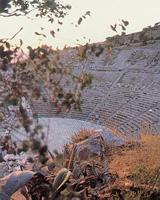 |
|
During the era of the natural philosophers, i.e. 600-545 B.C., Anatolian culture was of a brilliance unmatched in the world of its time, superseding Egypt and Mesopotamia Rejecting the idea of djinns, fairies and mythological causes, the natural philosophers investigated natural phenomena in a free spirit; Thales, son of the Carian Hexamyes, using the same methods we would today, predicted an eclipse of the sun for May 28, 585 B.C. This was the first prediction of a natural event in history. During the occupation of the Persians (545-333 B.C.), Anatolia relinquished its leadership, but regained it in the Hellenistic Age (333-30 B.C.). Throughout these centuries, Miletus, Priene, Ephesus and Teos were among the finest cities in the world, and the Anatolian architecture of this era greatly influenced Rome. |
|
| The Roman Age (30 B.C. - 595 A.D.)
The Romans developed the technique of mortaring bricks together, thereby producing arches, vaults and domes of large volume. These were the first major feats of engineering in history, and although the very first were at Rome, it soon became the turn of Anatolia Fine cities sprang up not only in the south and west of the peninsula, but also in its heartland. |
|
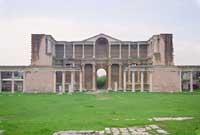 |
|
| In all of these cities there were such monumental works as an agora, gymnasium, stadium, theater, baths and foundations, and many of them were of marble. The roads, too, were paved with marble and lined with colonnades, thus protecting the citizens from sun and dust in the summer, and from cold and mud in the winter.
Water channeled into the cities via aqueducts sprang from the fountains, and a fine, well maintained network of roads and stone bridges connected the cities on the peninsula. Dozens of ancient cities in Western and Southern Anatolia, portions of them almost as they were in Roman times, fill visitors with awe. |
|
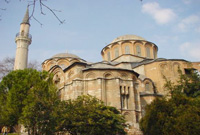 |
|
The First Christian State in the World
The Byzantine Empire (330-1453 A.D.)
Byzantine art was born in Anatolia at the end of the Roman era. As the Roman art of sculpture and architectural decoration entered a period of decline toward the end of the 3rd century, new life was breathed into them by early Christian practitioners of both arts. |
|
| One might say that early Christian and Byzantine art were an expressionistic rendering of Roman themes; where architectural space was concerned, they represented a whole new approach. For two and a half centuries, from 300 to 565 A.D., Constantinople (Istanbul) was the leading city of the world in art and culture. The most brilliant time for the early Christian era was the reign of Justinian (527-565).
Hagia Sophia, a centrally domed basilica, was built prior to this (532-539), and is the masterpiece of Byzantine art, one of the most famous works in the entire world.
The best preserved Byzantine religious buildings are Hagia Irini Church (6th and 8th centuries), the Basilica of St. John (Justinian's reign) and the Church of Mary (4th and 6th centuries), both in Ephesus, and the Alahan Church (5th and 6th centuries) in Southeastern Anatolia. From the Late Byzantine era the best preserved and finest works are St. Mary Pammakaristos (1310) next to Fethiye Mosque, and Kariye Mosque, that is to say the Chora Church, both in Istanbul. In the latter two buildings, the multidomed ceiling harmonizes beautifully with the walls and their three-staged arches.
The first people to dwell in all of Anatolia were the Turks. The Hittites, Phrygians and Greeks lived in only part of the peninsula. The Turks arrived in Anatolia from Central Asia by way of continual migrations and incursions, and through their policy of tolerance in government earned the love of the Indo-European peoples living on the peninsula. It was the Turks who adopted Islam, and on this basis mingled with the local peoples starting in 1071. The passage of nine centuries has resulted in present-day Turkey.
Until recently it was thought that contemporary Western civilization was based on the Greeks, but archaeology and history now show that it goes back rather to beginnings in western and south-western Anatolia. |
|
|
 |
|
|
|